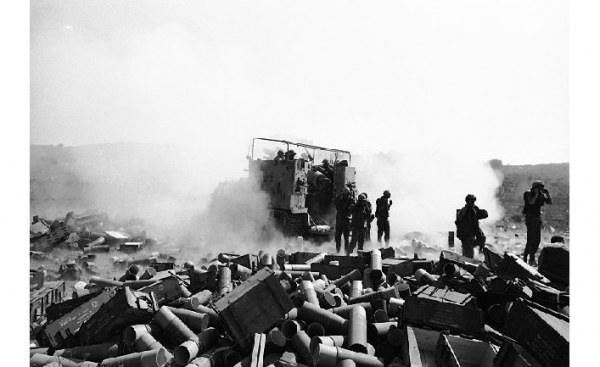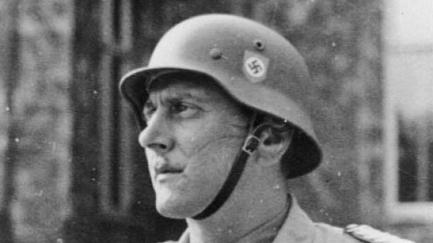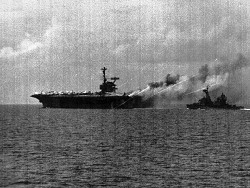
The Kalashnikov rifles that have become symbols of status, Katyusha rockets, which were fired by Lebanese terrorists, and tanks replaced the name: you will be surprised to learn that the Israeli army did with the weapons of their enemies.
Shay levy (שי לוי)
Tanks, armored personnel carriers, airplanes and missiles. Over time the Israeli army captured tons of captured weapons and used it in various operations. Some of the weapons placed at the disposal of the elite units, the part was used during special operations. Often weapons have served Israeli interests when we were arming them to friends or traded. From some captured units of equipment were able to obtain valuable information, while others were simply transferred to the Museum. Here are their stories.
Armored fighting vehicle in good condition
Over time, the Israeli military during different operations and wars captured many tanks and armored personnel carriers. Most were captured tanks T-54 and T-55, BTR-50, BTR-60 and BMP-1, and a number of other samples of armored vehicles. Part of the captured equipment was rusted and crumbled into dust, another part sold to foreign countries, earning a good idea, but some machines were taken into service in the IDF.
At the T, captured during Operation Kadesh in 1956, the six day war in 1967 and the Yom Kippur War in 1973, were replaced by engines and weapons. After the upgrade they assigned the name “Tyrant” and included in army brigade, mostly manned by reservists. T-55 tank was the tank “Tiran-5”, and captured during the Yom Kippur War tanks T-62 — “Tiran-6”. Captured tanks were so many that an entire division — 440-I — got “Tiran-5”. From “Tiran-6” was composed of a brigade that operated mainly in the North.
Tanks “Tyrant” to serve in the Israeli army before 90-ies. In addition, when it created the South Lebanon Army, the IDF handed her captured weapons, including Kalashnikovs and T-55.
15.05.2009 the Most interesting story associated with these tanks, occurred during the War of attrition. The Israeli army suffered losses from artillery shelling and operations of the Egyptian forces. In response, the Israeli air force heavily bombed Egyptian positions. Another variant of response actions — operation, such an operation “Raviv”, which began at 22 hours on 8 September 1969.
Six tanks “Tiran-5” and three BTR-50 were loaded onto a transport Israeli Navy. Tanks ran instructors, the APC has put the special forces soldiers PALSAR-7, elite soldiers of the engineering company of the airborne brigade and special forces soldiers of the General staff (Sayeret MATKAL) who knew Arabic. Tanks painted in camouflage coloring of the Egyptian army. The cars were planted South of Suez. Tanks and armored personnel carriers drove 70 kilometers, destroying all met the Egyptian technique, bunkers and guard posts, causing heavy damage to the Egyptian army. They also destroyed the radar, watching the sea and the air, thus facilitating the subsequent operations of the Israeli army.
Along the way, the Israeli military accidentally met General Kamal Hassan, commander of the Egyptian army plot, which was used for the operation. He was confident that before him the Egyptian army, and was killed when tanks crushed his car. Ten hours after the operation, Israeli Navy took soldiers and equipment. The Egyptian army lost about 150 men killed and about the same pieces of equipment. Who knows how many more goals flew in after that. Among Israeli soldiers, one soldier was lightly wounded. Was also killed major Hagai Ronen (חגי רונן) the pilot of the Skyhawk aircraft, cover ground forces.
Few people know that some of the APCS still are in service in the army. In 1980-ies the officer airborne brigade and engineer benny Beit-Or (בני בית אור) has developed a new armored personnel carrier, and cheap at the same time providing better protection for soldiers. An armored personnel carrier called “Achzarit”, and it is a T-55 with turret removed, modernized and are equipped with infantry weapons. “Achzarit” showed good results under fire anti-tank missiles and remains in service in the army.
Among the trophies of the Israeli army has tens of thousands of small arms — Kalashnikovs, Dragunov sniper rifle, machine guns, PK and RPD. RPGs, a favorite weapon of terrorists, also caught the Israeli military in large numbers. The IDF did not change their machines on the trophy, but at the same time, took them into service for some elite units, and over time, these weapons have become a status symbol.
The most famous example is the Kalashnikov assault rifle, which became the service weapon of the fighters of the 13th flotilla (naval commando), mainly thanks to the resistance to the water. On many promotional photos distributed by the army, you can see fighters of this division, leaping out of the water with Kalashnikovs in hand, often include different additives, for example, a night vision device or a grenade launcher. The machines were also in the special forces of the General staff, in addition, their loved some senior commanders. By the way, in the 1970-ies the main gun in the army was hated by the soldiers of the Belgian FN. Soldiers often threw them and armed with taken from slain enemies Kalashnikov.
Guns PC and the RAP also got into the army — they were armed soldiers of the unit “Egoz”, walked into an ambush during the existence in Lebanon security zone. These guns killed a lot of terrorists in the 1990-ies, and also become a symbol of prestige. During the Second Lebanon war the IDF again received the trophy PC from Hizbollah, but this time they were not taken on Board.
Dragunov sniper rifle (SVD) have gained popularity, especially among special forces soldiers. These weapons came in the division “Yael” and other elite units of the pioneer corps of engineers. It is also interesting that these weapons were “Chechens of the IDF”, a group of immigrants from Russia, served in Russian army and snipers who fought in Chechnya. During the Second intifada they were allowed to operate quite freely in Gaza and they shoot dozens of terrorists.
One more weapon has gained popularity in the army, this grenade launcher RPG. The Israeli military first encountered him on the Yom Kippur War, and the grenade launcher made a name for himself in the fight with tanks and armored vehicles of the IDF. Then we saw him again during the First Lebanon war. The weapon was used there broadest way and caused many losses of the Israeli army. Then there was the so-called “children of the RPGs”, armed with rocket-propelled grenades children, attacked the soldiers. This weapon, unlike the other samples, came only for an elite unit, became the basic weapons, which include all the army battalions. At the moment they still are reservists.
“Katyusha” rockets, which have caused many problems to the population of the Northern areas, also visited the service in the Israeli army. In the late 1960-ies appeared the battery, equipped with the trophy missile launchers captured during the six day war. Battery used two types of installations, caliber 240 mm BM-24) and 130 mm. These missiles fired at terrorist bases in Lebanon, the intelligence of the group and of the Egyptians.
IDF reserve battalion that participated in the Yom Kippur War, used the “Katyusha”. They were also used in the First Lebanon war — soldiers used unexploded missiles and released them back to the terrorists. After the war they were removed from service.
The aircraft as a gift
From the sky the Israeli army is also falling trophies. Some planes and helicopters were captured in the battles, some accidentally, but others can really be considered a gift.
In the 1950-ies and 1960-ies Soviet-made aircraft, the MiG-17 was the main aircraft of military aircraft of the Arab States. Of course, Israeli intelligence tried very hard to get information about that bird to ease the pilots task in fighting with her. It happened as if by order.
12 August 1968 the pilots of the Syrian air force Lieutenant Walid Adham and Lieutenant Radfan Raphael was performing a training flight two MiG-17. They had old maps, which they got lost and flew into Israel. They sat down at the Israeli airport in complete confidence that they are in Lebanon. Pilots captured and released two years later. The planes Syria is no longer seen. Took them apart and carefully examined by Israeli experts, and then as a gesture of goodwill sent to the United States, One of the aircraft was then returned to Israel and handed over to the aviation Museum.
More known case with the MiG-21. This aircraft in 1966, brought to Israel by Iraqi pilot Munir, Rdfa, thanks to an impressive operation “Mossad”. He landed the plane in the Israeli air force base tel Nof. As in the case of the MiG-17, this aircraft was carefully studied, and Israeli pilots flew it, and then he was sent to the United States, which had to deal with the MiG-21 in Vietnam. Then the plane is also exhibited in the Museum of aviation.
Arab deserters also brought to Israel the Yak-11 in 1964, but this training aircraft was not too impressed by the Israeli air force. Egyptian captain Mahmoud Abbas Hilmi went to live abroad and was killed by agents of the intelligence services of Egypt. The plane, which he brought to Israel, was given to the British along with several captured tanks in exchange for the Harvard aircraft.
Another thing, the MiG — 23. This “gift from heaven” was very interested in the Israeli military. The aircraft delivered to the Syrian pilot major Bassam Adel, who fled to Israel 11 October 1989. The MiG-23 were made 18 test flights, and the information collected allowed the Israeli air force to establish his weaknesses. After this, the aircraft joined the Museum collection.
During the Yom Kippur War the Egyptian military conducted a large-scale operation commando, and many soldiers were taken to the front line by helicopters Mi-8 Soviet-made. One helicopter unsuccessfully sat down and broke the front nose gear. An Egyptian pilot came out to inspect the damage, and rotating the screw blew his head off. The rest of the crew and the Marines fled, leaving the helicopter. Mi-8 has found the base commander “Rafidah” Cohen, Eliezer (אליעזר Sosna), himself a military pilot, piloting helicopters. He brought the helicopter to its base and studied it with the help of captive Egyptian pilot. It is a helicopter in the Museum didn’t get it sold to Americans for a million dollars.
The Syrian military used French helicopter Gaselle, including against Israeli tanks in the First Lebanon war. Many of these machines were shot down by Israeli aircraft and air defenses. Two of them brought to Israel and repaired. One of them participated in the parade of the air force in 1982, two weeks after capture. Both the helicopter several years served in the army, then one was transferred to the Museum, and the second — sold “the Electric company” for works on maintenance of power lines.
From Lebanon to South America
Israel used captured weapons to promote their interests, including in overseas countries. The trophies used for the arms of the South Lebanon Army, and passed on to the Kurds. In addition, many weapons were sold, which brought into the Treasury hundreds of millions of dollars.
Israeli weapons are also dark history. In 2010, the Pentagon released documents on the operations of Kumkum Akum 1″ (Hebr. “Curve maker”) and “Kumkum Akum 2”, during which the U.S. Department of defense to buy weapons seized by Israel during the First Lebanon war, and gave it to contras, opponents of the government of Nicaragua. We are talking about the Kalashnikov assault rifles, machine guns, artillery pieces, mortars and tons of ammunition. The machines sold for 210 dollars apiece, mortars calibre 60 mm — for $ 1,500, with a caliber of 81 mm — $ 5,000. The prices are too high, but that’s not it.
Due to the disclosure of the scandal, Israel was involved in wars in Latin America. However, this is only a small part of the scandal the “Iran-contra” when the Israeli guns fell to the regime of the ayatollahs.








